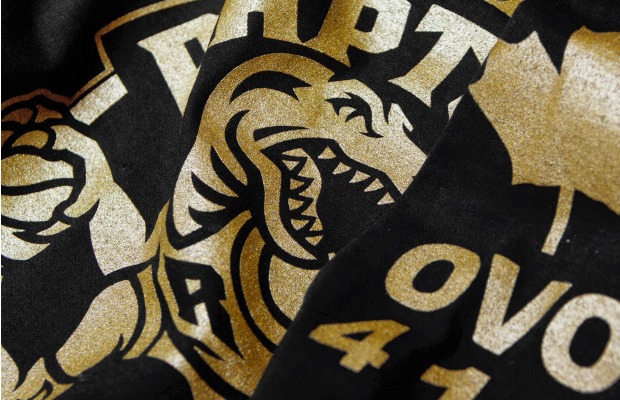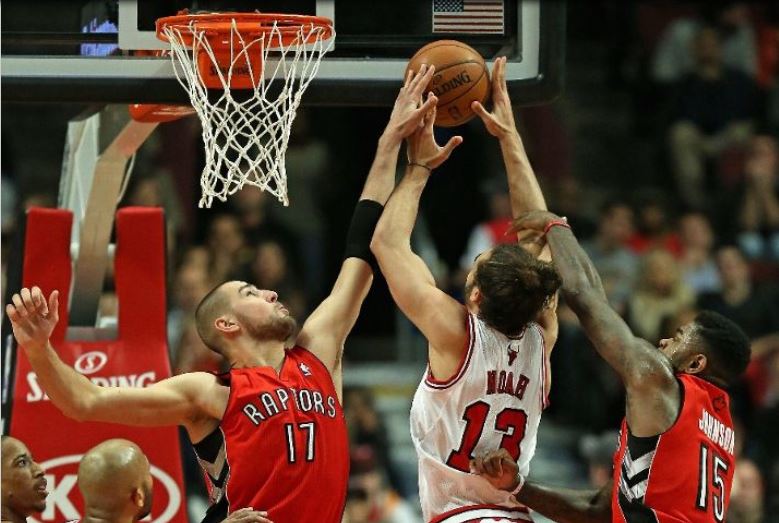When I started following the NBA, player development was a bit different than it is today. In 1985, three of the top five players drafted were college seniors. And the two who did come out early still played three years of college ball. True international players (foreign born players who had never played basketball in the US) were rare and footnotes at best. And teams never selected international players in the first round of the draft, which had seven rounds in all.
In the 2013 draft, only one player played at least three years of college ball, and that’s rare for a lottery pick nowadays. In the 2011 draft, the average number of years of college experience among the top five players drafted was LESS than one year. Kyrie Irving and Tristan Thompson were both freshman, and Enes Kanter and Jonas Valanciunas had never played college ball.
The first international player that I recall have any kind of an impact was Drazen Petrovic, a gifted shooter who was already 25 years old by the time he played his first NBA game. The first international player drafted in the first round was Arvydas Sabonis, in 1986. Sabonis was a truly gifted big man, but the fact that he was from the Soviet Union meant it was unlikely he would play in the NBA in the near future, and didn’t actually make his NBA debut until he was in his 30s and was a shadow of his former self 1.
[aside]1. Sabonis might very well have been a top ten center/centre of all time had he played in the NBA in his prime. There isn’t a whole lot of footage to be found of him before injuries ravaged his body, but this is one example. In his first season in the NBA, at 31, if his body had been able to handle playing 36 minutes a game, he would have averaged 22 ppg, with a TS% of .617, including shooting .375 from three, 12.2 rpg, 2.7 apg and 1.6 bpg. His CAREER PER average is 21.2 and he had the sixth highest PER and fourth highest WS/48 of any rookie in the history of the league.
[/aside]The first international player drafted in the first round to actually play in the NBA in his prime was Vlade Divac. The Lakers, always ahead of the curve, drafted him with the last pick in 1989 and he made the All Rookie first team the next season.
By the time the Raptors drafted the 19 year old Valanciunas with the 5th pick, in 2011, international big men were a common sight in the league. The same month Valanciunas was drafted, former MVP Dirk Nowitzki lead his Dallas Mavericks to a Championship.
But that doesn’t mean that the development of a player like Valanciunas is now common. In the history of the league, there have only fifty big men that have come into the league at 20 years of age or younger. And until fairly recently, teams would develop these young big men by gluing them to the bench and bringing them along slowly in practice. Of the only sixteen rookie big men, aged 20 or younger, that played fifteen minutes per game or more, all but three came into the league after 2000.
I bring all this up to emphasis just how difficult it is to compare a player like Valanciunas to any other player that came before him.
And none of that touches on his basketball experience BEFORE he hit the NBA. There are dozens of leagues just in Europe, and not all are created equal. Even the different leagues in Spain aren’t at the same level. When Pau Gasol came into the NBA, he had already been playing in the top league in Europe for several years. The NBA was a jump, but not as big as Valanciunas made from the top Lithuanian league, of which he’d been playing in for only one year before he came to the NBA.
Valanciunas had only been playing in Lithuania’s top league for one year before heading to the NBA. And his english was spotty, at best. Plus the entire population of Lithuania is less than that of the Greater GTO. Make no mistake that Valanciunas had more of an adjustment to make than the average rookie, who generally doesn’t have to deal with learning a new language and new culture (Canada is a different country than the US, obviously, but there shouldn’t be a whole lot of culture shock for Americans).
At the end of last season, I took a bit of a snapshot of Valanciunas’ rookie season and compared his numbers to Chris Bosh as well as Brook Lopez. So how has he done so far this season?
Well, for the sake of discussion, let’s look at how he compares to some other players, in their second season, who have some similarities.

I used the Per 36 numbers, here, to give a better indication of production regardless of how many minutes each player played.
In the previous article on Valanciunas, I compared him with Chris Bosh, and in the second season there is more of a disparity. Bosh scored and got to the line more, but grabbed fewer rebounds than Valanciunas.
One player I thought would be interesting to look at, in comparison to Valanciunas, was Divac, who had a productive career, became a top ten center in the league and made one All Star game. Divac shot a much better percentage, in his second season, but otherwise their numbers are fairly similar.
Marc Gasol is the oldest of the bunch, and entered the league with more experience than any of the other players on the list, but I’d thought he’d be an interesting comparison, nonetheless.
Valanciunas’ offense doesn’t look great, from these stats. He shoots the third lowest shooting percentage, but the two players below him both have a much bigger offensive burden than he does and score more points per game. He also is tied with Horford as the worst getting to the line. He is the best rebounder, of the bunch, though.
Looking at their Advanced Stats:

We see many of the same issues here. Among the six players, his PER is by far the lowest, and the only one below average (15 is average). His TS% is nearly identical to Bosh (and second lowest), but he’s got a much lower Usage. What’s most troubling is his Free Throw Rate, which was an excellent .505 last year and is at a mediocre (for a big man) .312 this year and is the lowest of the bunch.
One interesting similarity he has with Divac is that they both had a similarly low Assist Percentage and similarly high Turnover Percentage, in their second year. Divac became a very good passer, something it would be nice to see with Valanciunas, but there’s no reason, at this point, to believe that will be so.
Unfortunately, Valanciunas has seen a decline in many offensive categories over last season. He’s scoring less, shooting a much lower percentage from the field, getting to the line at a lower rate, as mentioned, and passing the ball less.
We can take a look at the decline of his stats, especially on the offensive end.


He’s increased his scoring, but he’s also taking more shots and scoring less efficiently.
He has steadily improved as the year has progressed, though. His TS% has increased each month, going from .522 in October, to .566 in December and is shooting .584 in January. His scoring and rebounding have decreased slightly this month, though, as has his Offensive Rating.
Delving deeper, we look at some more advanced stats, from mysynergysports.com.
Valanciunas is posting up a little more (31.3% as opposed to 26.7% last year) and scoring about the same points per possession. He also scores well off the offensive rebound (27th in the league with 1.11 ppp). That’s the good news. His pick and roll game has declined dramatically, however, as he’s getting fewer pick and rolls this year (14.8 % vs 19.9%) and he’s scoring quite a bit less on them (.85 ppp vs 1.23 ppp), as well. He’s also shooting only 42.2% on pick and rolls. Now, there are no stats available to see if all this has improved since the Gay trade (I’m guessing he’s getting more, but I’ve no idea if he’s scoring more on them).
In fact he’s scoring fewer points per possession over all, this season. Last season he scored 1.02 ppp, which ranked him 39th in the league. This year he’s scoring just .94 ppp, ranking him 136th. That’s still above average, but much more of a drop off than one would expect even taking into considering the fact he’s taking more shots.
It’s difficult to say exactly why Valanciunas’ scoring has suffered. If it were just that he’s getting fewer pick and rolls, that would be one thing, but he’s scoring less on them even when he gets them. Perhaps teams are defending the pick and roll differently, or perhaps the Raptors are simply playing the pick and roll differently themselves. The combination of Lowry and Valanciunas was actually a little better, offensively, than the combination of Calderon and Valanciunas, so it’s not as if the loss of Calderon should have had an effect.
Next, we look at NBA.com’s Shooting Charts, and maybe discover why Valanciunas is struggling more from the field.
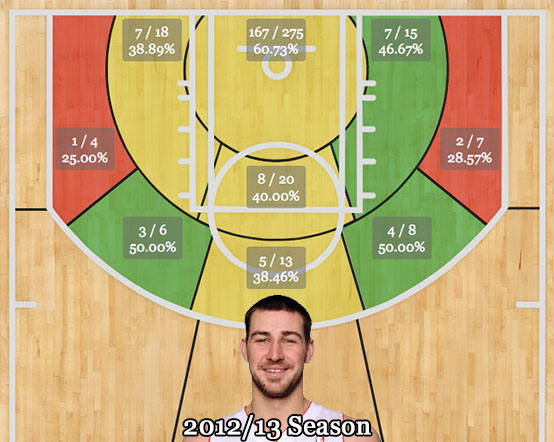
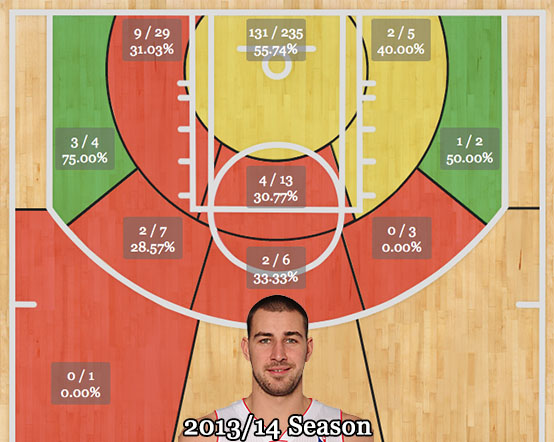
From the above charts, we can see that Valanciunas’ shooting percentage has gone down in nearly every zone. Only the long shot from the wing has improved, but he’s taken only a few shots from there, so it’s too small a sample size to really ascertain anything.
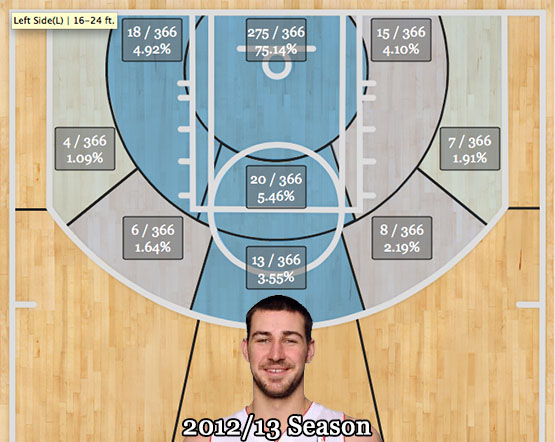
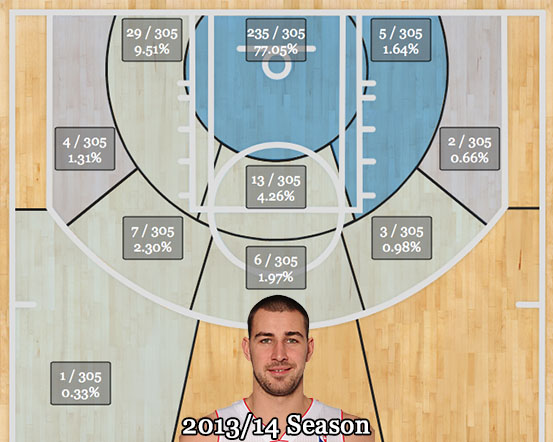
Interestingly, he’s taking FEWER outside shots this year, but his shooting percentage and free throw rate has gone down.
Going strictly from watching Valanciunas, he seems to be forcing more shots than last year, and getting fewer within the flow of the offense (he’s in danger of becoming a ball stopper on offense). And while he’s added strength, he seems to be getting his shot blocked much more this year than last year (there are probably stats available for this, but I’m not sure where to find them), and against the Bucks last night he got his shot blocked three times in one sequence. While he’s gained strength, I’m guessing more is necessary in order to power through many of those blocks for a dunk and foul.
On the other hand, there are some positives regarding Valanciunas’ development this year.
Valanciunas has made good strides on the defensive end. He’s allowing fewer points per possession by his opponent than last season, although there are still improvement needed, and has actually become a good at defending the post, where he’s ranked 22nd in the league, per mysynergysport.com.
His Defensive Rating has gone down, which is a good thing, although that’s partially because the team is better defensively.
He’s blocking fewer shots but that may be him playing smarter defense. Don’t fall for the argument that you can tell how good a defender someone is by how many shots they block. You just have to look at JaVale McGee to see that’s not true.
Valanciunas’ added strength and experience has also helped him rebounding the ball, where his rebounding percentage has increased nearly two full percentage points (his per 36 numbers have gone up a full rebound and a half, from 9 to 10.5). He’s become not only a better defensive rebounder, but a better offensive rebounder, as well.
And, not surprisingly, his fouls are also down this year.
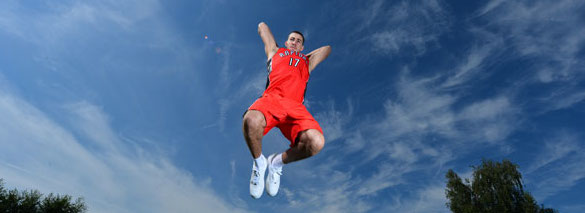
While Valanciunas has had his struggles on the offensive end, the improvement he’s shown on the defensive end has been very encouraging. While he’s scoring less and getting to the line less, it’s not as if he hasn’t shown the ability to score well. He can score with either hand in the post and he does possess a soft touch. He just needs to get back to what was working last year.
And we have seen improvement on offense as the year has gone on, which is a very good sign. There are some issues on that end, though, that are a little concerning that the coaching staff needs to address, but there is still reason to be very optimistic about Valanciunas and his development.
While it’s natural to try and compare Valanciunas with other players, it’s simply not fair to him and doesn’t make a whole lot of sense, considering their various backgrounds. He was compared to Joakim Noah a lot initially (including by Dwane Casey), but Noah had the advantage of playing three years at one of the top colleges in the US (and won the NCAA title twice in that time), and had lived in the US for most of his teenage years. Plus, Noah exhibited incredible defensive instincts that Valanciunas didn’t at the same age.
While I don’t generally like comparisons, I have stated that I see Valanciunas’ ceiling as someone like a Brad Daugherty (although without his passing ability). Daugherty and Valanciunas have similar athleticism, and Daugherty was a good, but not great scorer and good, but not great defender. It will take a lot of work and continued development from Valanciunas to achieve this level, but from what I’ve seen so far I believe that’s achievable.
The long term future of the Raptors rests more with Valanciunas than any other current player. While DeRozan and Lowry are in All Star discussions, neither has the ability to potentially affect the game on both ends of the court as much as a big man like Valanciunas could.


